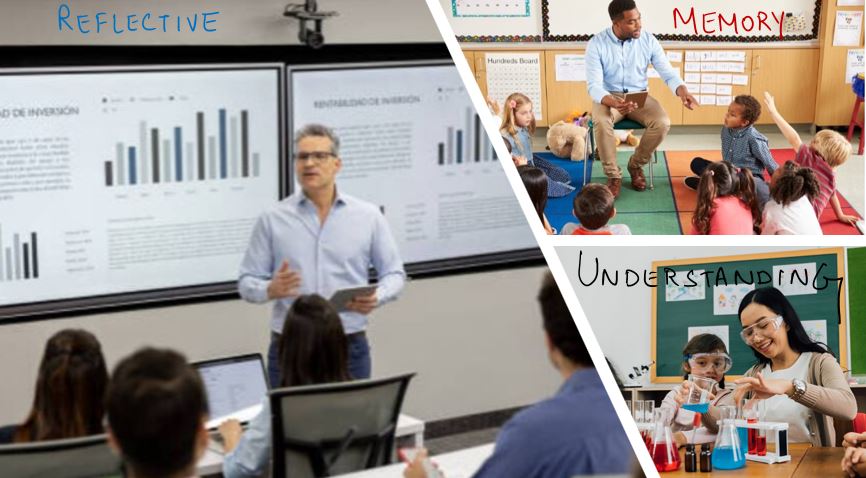Levels of Teaching

Teaching and learning can happen in different ways, from simple to complex. Let us look at Levels of Teaching. In teaching, there’s a connection between an experienced teacher and a less experienced student. Teaching is when a teacher helps a student learn new things. Teaching and learning go hand in hand. The main goal of teaching and learning is to help the student develop in all aspects.
-
 ₹3,500.00 – ₹6,500.00Rated 0 out of 5
₹3,500.00 – ₹6,500.00Rated 0 out of 5Prepare with the most trusted guide for UGC NET since 2011. What you will get: Video Classes covering 100% Syllabus Syllabus oriented content (not just random PDFs or class notes....
There are the following 3 identifiable levels of teaching and learning activities.

1. Memory Level of Teaching (Herbert’s Teaching Model)
The first level of teaching is Memory Level of Teaching. It is also called thoughtless teaching. Johann F. Herbart, a German philosopher and founder of pedagogy as an academic disciple, was the exponent of Model of Memory-Level Teaching.
At Memory Level of Teaching, the focus is on memorisation. It is usually used in lower classes. The instructional arrangement is such that the learner is helped in cramming the content presented to him. Here, the teacher gives factual material which students memorize without understanding it. This type of teaching is based on the S-R conditioning theory of learning in which bondage is formed between the stimuli (S) and response (R) without involving any purpose. In other words, the main focus is laid on capturing and systematic presentation of ideas and information.
In this level, the teacher presents factual information before the learner. The learner tries to cram and mug up these facts with the least involvement of his thinking and reasoning power without any care of the understanding of their meaning and application. The learner is supposed to retain the information as long as possible and to reproduce (recall or recognize) it when needed. The whole efforts in such teaching act then revolve around the acquisition of the factual information or knowledge through rote learning.
Examples of Memory Level of Teaching
1. Teaching basic math operations (e.g., addition, subtraction) in primary school.
2. Instructing spelling rules (e.g., silent ‘e’ rule) to elementary students.
3. Teaching basic colors (e.g., red, blue, yellow) to preschoolers.
4. Instructing simple counting (e.g., counting to 10) to toddlers.
2. Understanding Level of Teaching (Morrison’s Teaching Model)
The main proponent of Understanding Level of Teaching is H. C. Morrison. The teaching at the Understanding Level is of higher quality as compared to the teaching at Memory Level. Teaching-learning at this level emphasizes the comprehension of the meaning by giving large number of positive and negative examples to explain any concept. It is more useful and thoughtful as it focuses on the mastery of the subject. Teaching at this level is done to develop intellectual behaviour and help to promote seeing of relationships among facts. Learners become more capable to think and present the facts in good manners. They also analyse the facts properly and draw inferences.
Teaching-learning at the Understanding level emphasises seeing solitary facts in relation to general principles. It involves exploration, presentation, assimilation, organisation and recitation through oral presentation or in the form of written paper.
This type of teaching-learning can be carried out with the students in upper primary, middle and higher classes.
Examples of Understanding level of teaching
1. Explaining historical events (e.g., the American Revolution) in middle school.
2. Analyzing literature (e.g., Shakespearean sonnets) in high school English classes.
3. Investigating chemical reactions (e.g., combustion, photosynthesis) in chemistry labs.
4. Exploring ecological systems (e.g., rainforests, deserts) in middle school science classes.
3. Reflective Level of Teaching (Hunt’s Teaching Model)
Reflective Level of Teaching is also known as “introspective level of Teaching” or “exploratory understanding”. Hunt is the main proponent of Reflective Level of Teaching. It is the highest and the most practical level of teaching. This level basically involves the use of scientific methods to understand the problems.
The Reflective Level of Teaching is highly thoughtful and useful. A learner can achieve this level only after Memory Level and Understanding Level. Students at this level develop curiosity, interest, inquiry and persistence which culminates in a scientifically determined conclusion or solution of a problem. Teaching-learning at Reflective Level involves careful and critical examination of an idea or problem through problem-Solving Approach.
Examples of Reflective Level of Teaching
1. Discussing advanced physics concepts (e.g., quantum mechanics) in university courses.
2. Conducting research projects (e.g., on climate change) in graduate-level studies.
3. Formulating business strategies (e.g., market entry plans, SWOT analysis) in MBA courses.
4. Debating philosophical theories (e.g., utilitarianism, existentialism) in undergraduate philosophy seminars.
UGC NET Questions for Practice (Levels of Teaching)
1.) In which level of teaching, the main focus is laid on capturing and systematic presentation of ideas and information? (UGC NET 20 Nov Morning 2021)
(A) Memory level
(B) Understanding level
(C) Reflective level
(D) Autonomous development level
2.) In which level of teaching, promotion of critical thinking is the hall mark? (UGC NET 20 Nov Evening 2021)
(A) Memory level
(B) Understanding level
(C) Reflective level
(D) Autonomous development level
3.) Which of the following is the highest level of teaching? (UGC NET 24 Nov Evening 2021)
(A) Memory
(B) Understanding
(C) Reflective
(D) Thinking
4.) Which of the following level of teaching lays stress on critical shifting of ideas at the highest cognitive level? (UGC NET 03 Dec Morning 2021)
(A) Memory level
(B) Understanding level
(C) Reflective level
(D) Autonomous development level
5.) The objective of reflective level teaching is: (UGC NET 04 Dec Morning 2021)
(A) To impart knowledge to the learners.
(B) To develop insight into the learners to solve problems.
(C) To make students relate facts with the principles.
(D) To encourage students to apply knowledge in similar and different situation.
6.) Which of the following is true about understanding level of teaching? (UGC NET 05 Dec Morning 2021)
(A) Imparting factual information.
(B) Teaching to comprehend the concepts.
(C) Teaching to explore the field of knowledge.
(D) Teaching to develop rational thinking.
7.) Given below are two statements: (UGC NET 05th Mar 2023 Morning)
Statement I: The objective of the memory level of teaching is to develop rational and critical thinking among students.
Statement II: The objective of the reflective level of teaching is the ability to develop independent thinking and decision making among students.
In the light of the above statements, choose the correct answer from the options given below:
(A) Both Statement I and Statement II are true.
(B) Both Statement I and Statement II are false.
(C) Statement I is true but Statement II is false.
(D) Statement I is false but Statement II is true.
Answers
- A
- C
- C
- C
- B
- B
- D



